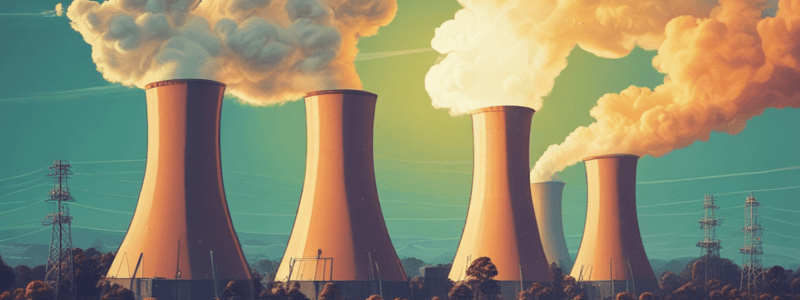Podcast
Questions and Answers
What will happen to energy prices if the Coalition government slows the renewables' roll-out and uses gas to fill the supply gap until nuclear plants are operational?
What will happen to energy prices if the Coalition government slows the renewables' roll-out and uses gas to fill the supply gap until nuclear plants are operational?
- Energy prices will remain the same
- Energy prices will decrease
- Energy prices will only go up (correct)
- Energy prices will fluctuate
Who decides on renewable energy targets and state policy roadmaps?
Who decides on renewable energy targets and state policy roadmaps?
- Local councils
- State governments (correct)
- The federal government
- Private companies
How many gigawatts of capacity would seven small and large nuclear reactors add to the grid?
How many gigawatts of capacity would seven small and large nuclear reactors add to the grid?
- Five gigawatts
- Twenty gigawatts
- Ten gigawatts (correct)
- Fifteen gigawatts
According to CSIRO research, how much more expensive is electricity produced by a large-scale nuclear plant in Australia compared to firmed renewable energy?
According to CSIRO research, how much more expensive is electricity produced by a large-scale nuclear plant in Australia compared to firmed renewable energy?
By what year will Australia's annual electricity consumption from the grid need to double to meet electrification needs?
By what year will Australia's annual electricity consumption from the grid need to double to meet electrification needs?
What is the Coalition's argument for having a balanced energy system?
What is the Coalition's argument for having a balanced energy system?
What has the Coalition not explained about its balanced energy system?
What has the Coalition not explained about its balanced energy system?
What has the Opposition energy spokesman promised to provide before the federal election?
What has the Opposition energy spokesman promised to provide before the federal election?
What is the current concern about the Coalition's policy on energy prices?
What is the current concern about the Coalition's policy on energy prices?
What is the total amount of electricity generation needed to meet electrification needs by 2050?
What is the total amount of electricity generation needed to meet electrification needs by 2050?
What is the main concern about the Coalition's nuclear energy plan?
What is the main concern about the Coalition's nuclear energy plan?
When is the first nuclear plant expected to be operational?
When is the first nuclear plant expected to be operational?
What is likely to happen to energy bills if the Coalition's plan replaces coal with gas in the medium-term?
What is likely to happen to energy bills if the Coalition's plan replaces coal with gas in the medium-term?
What is the main purpose of gas in the energy system, according to the article?
What is the main purpose of gas in the energy system, according to the article?
What is the expected outcome of the Coalition's policy on energy prices in the next five to ten years?
What is the expected outcome of the Coalition's policy on energy prices in the next five to ten years?
What is the situation with coal plants in Australia, according to the article?
What is the situation with coal plants in Australia, according to the article?
What is the relation between gas and coal in terms of cost?
What is the relation between gas and coal in terms of cost?
What is the expected outcome of the Coalition's plan on greenhouse gas emissions?
What is the expected outcome of the Coalition's plan on greenhouse gas emissions?
Flashcards are hidden until you start studying
Study Notes
Energy Prices and the Coalition's Nuclear Plan
- The Coalition's nuclear energy plan, announced by Opposition Leader Peter Dutton, lacks costings and modelling, making it unclear how it will affect energy prices.
- The first nuclear plant, if built, would not be operational for at least a decade, which is an optimistic timeframe.
- Replacing coal with gas in the medium-term would likely increase energy bills and greenhouse gas emissions.
- Gas is expensive compared to coal and is better suited for balancing a high-renewables system to meet weather-related shortfalls.
- Slowing down the rollout of renewables and speeding up gas production would drive up energy prices.
Nuclear Energy Capability
- The Coalition plans to build seven small and large nuclear reactors, adding about ten gigawatts of capacity to the grid.
- This is a small proportion of the generation capacity needed in the later 2030s.
- CSIRO research suggests that electricity produced by a large-scale nuclear plant in Australia would be at least 50% more expensive than firmed renewable energy.
Future Energy Prices
- Australia's total electricity generation must increase enormously to meet the electrification needs of other parts of the economy.
- Annual electricity consumption from Australia's grid will need to double by 2050, to about 300 gigawatts.
- The total system costs matter when it comes to electricity prices, and ten gigawatts of nuclear would be a very small part of the mix.
Criticism of the Coalition's Plan
- The Coalition has not explained what a "balanced" energy system would look like or what roles each technology would play in that system.
- The plan lacks detail on how it will address cost-of-living challenges now or in the 2030s and beyond.
- The Coalition's policy is likely to have the opposite effect of bringing down energy prices.
Studying That Suits You
Use AI to generate personalized quizzes and flashcards to suit your learning preferences.




